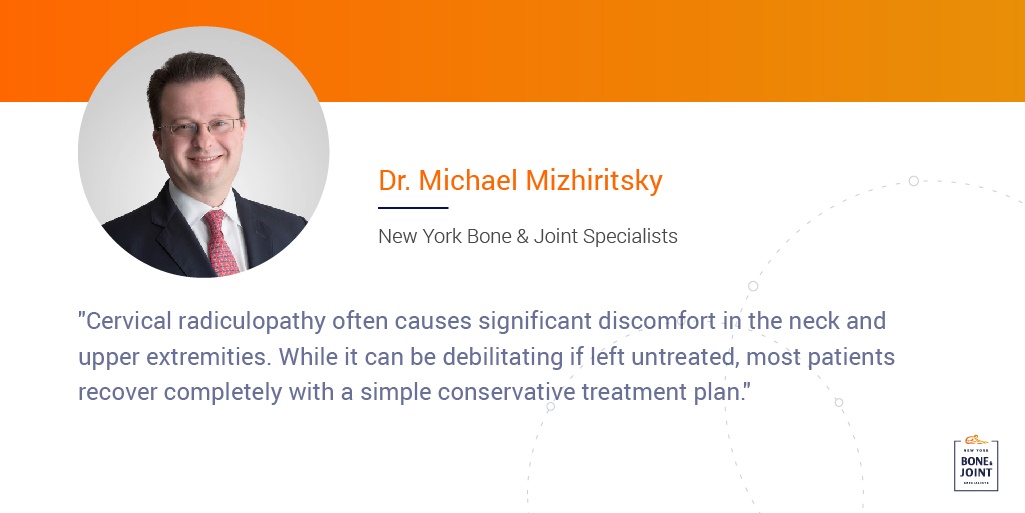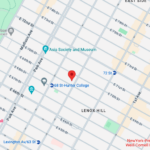Do your legs feel wobbly when you walk? Do you experience a tingling sensation down your arm? These are classic symptoms of a pinched nerve, a common condition caused by the compression of one of the 31 nerve pairs that branch out from the spine.
Pinched nerves most often occur in the lower back, neck, shoulder, and wrist. Since a pinched nerve is typically the result of another orthopedic condition, such as arthritis, bone spurs, or degenerative disc disease, you’ll need the expert advice of one of the pinched nerve specialists at New York Bone & Joint Specialists for an accurate diagnosis.
The majority of mild pinched nerve cases resolve on their own within days or weeks with at-home care and rest. However, if you’re experiencing severe pain that doesn’t subside within several weeks, consult with one of our board-certified orthopedists for a diagnosis and care plan that starts with conservative treatment. If you need surgery, our orthopedic surgeons use minimally invasive techniques for faster, simpler recovery.
What is a Pinched Nerve? Understanding Nerve Compression
Throughout your body are nerves that carry electrical signals between your brain and the rest of your body. They control voluntary movements, such as when you move your muscles, and involuntary actions like breathing, sweating, and digestion. Your nerves also allow you to touch, see, taste, and smell.
Your nervous system consists of two parts:
- The central nervous system includes the brain and spinal cord, which receive signals from the peripheral nervous system
- The peripheral nervous system transmits nerve impulses from your body to your spinal cord
When a nerve experiences pressure from an outside force, it can become irritated and possibly damaged. Sometimes, nerves can be pinched or “squeezed” by surrounding tissues, such as muscles, ligaments, or tendons. This can cause pain, numbness, or tingling sensations in the extremities. A bone spur is another common cause of a pinched nerve. Pinched nerves are also known as nerve entrapment.
Inflammation in the soft tissue around the nerve can also cause nerve compression. The body’s natural response to injury is swelling, but that swollen tissue can pinch a nearby nerve. When a nerve is compressed, it interferes with the nerve’s function and sends pain signals to the brain.
Pinched nerve pain may be temporary and remedied with rest and at-home treatments in a few days. In more serious cases, the pain can become chronic and long-lasting. A medical evaluation is needed if the pain continues for weeks.
Pinched Nerve Symptoms: Recognizing the Signs
When a spinal nerve is pinched, the medical term is radiculopathy. Depending on where the pinched nerve is located along the spine, it will cause different symptoms. In general, here are the characteristics of a pinched nerve:
- Pain: Sharp, shooting, or burning pain in the area of the pinched nerve
- Paresthesias: Numbness and tingling sensations, most notably in the arms or legs. It may feel like the limb has “fallen asleep”
- Functional limitations: The muscles feel “weak,” making it difficult to walk or grasp objects
- Movement-related pain: Due to the location of the pinched nerve, pain may worsen with certain movements or positions. For example, low back pain due to a pinched nerve intensifies when sitting or standing for long periods, or when coughing and sneezing
- Referred pain: Because spinal nerves carry nerve impulses to other parts of the body, the nerve pain may radiate to other areas, such as your arms or legs
- Bowel and bladder problems: A pinched nerve lower in the spine may interfere with bowel and bladder functions. This indicates serious nerve damage and needs immediate medical attention
Pinched Nerve in Neck: Cervical Radiculopathy
Cervical radiculopathy refers to pinched nerves in the cervical portion of the spine. The cervical spine consists of seven vertebrae numbered C1 through C7. Half of all cervical radiculopathy cases impact the C7 nerve, while a quarter center on the C6 nerve root.
Cervical radiculopathy is unilateral, meaning it’s felt on only one side of the body.
Symptoms by Location:
C5 Nerve:
- Pain in the neck, around the shoulder blade, and in the upper arm to the elbow
- Weakness when raising your arm away from the body, external rotation, and elbow flexion
- Numbness or tingling in the upper arm and shoulder area
C6 Nerve:
- Pain in the neck, forearm, thumb, and index finger
- Weakness in the elbow, forearm, and wrist extension
- Numbness or tingling on the thumb side of the hand
C7 Nerve:
- Pain in the lower neck, between the shoulder blades, outer forearm, and middle finger
- Weakness in elbow extension, forearm pronation (inward rolling), wrist flexion, and finger extension
- Numbness or tingling in the back of the arm and the middle finger
C8 Nerve:
- Pain between and below the shoulder blades, forearm, and the ring and little fingers
- Weakness in the hand that controls finger movement and finger flexion
- Numbness or tingling in the little finger

Common causes
Disc diseases
Disc disease is a common cause of pinched nerves and is typically seen in older adults due to the wear and tear on joints and cartilage.
- Herniated disc. The disc between the vertebrae ruptures and the interior fluid leaks out, irritating a nerve root.
- Degenerative disc disease. The fluid inside the disc dries up, causing the bones to rub against each other and irritate a nerve.
Spinal stenosis. A narrowing of the spinal canal squeezes the nerves in the spinal cord.
Bone spurs. The body builds a bone spur in response to the collapsed disc. The bone spur then narrows the foramen, the small opening on each side of the spinal column where the nerve roots exit. With less room to move, the nerve becomes compressed..
Trauma. Pinched nerves are more common in older adults, but can happen to younger people as the result of a sudden trauma to the spine.
Cervical radiculopathy symptoms:
- Pain in the neck that travels down to the arm.
- “Pins and needles” in the hand or fingers.
- Weakness in the muscles of the arms, shoulders, or hands.
- Pain increases when compressing or irritating the nerve, such as when straining the neck or turning the head.
- Pain lessens when putting your hands on your head.
Other factors affecting pinched nerve pain in the neck:
Sleeping position. Neck pain can make it difficult to find a comfortable sleeping position. A cervical pillow that maintains the natural curve of the spine at rest can relieve pressure on the nerve.
Workstation. How your desk is set up can exacerbate pinched nerve pain. Position your computer monitor at eye level so you’re not leaning forward and looking down.
Symptoms of Pinched Nerve in Neck and Shoulder
Symptoms of a pinched nerve in the neck or shoulder include:
- Sharp, shooting, or aching pain in the neck, shoulder, and arm.
- Numbness and tingling in the fingers, hand, or arm.
- Weakness in the arm or hand makes grasping objects or holding a pen difficult.
- Difficulty turning the head or moving the shoulder.
- Pain radiates to the shoulder blade or upper back.
- Headaches.
- Vertigo or dizziness.
- Muscle spasms in the neck or shoulder.
- Interrupted sleep.
Pinched Nerve in Shoulder Blade: Thoracic Nerve Issues
A pinched nerve in the shoulder is frequently due to nerve damage in the brachial plexus, the group of nerves that transmit nerve impulses from the spine to the arm. An injury or repetitive movements can cause a pinched nerve in this area.
Symptoms
- Unusual sensations on the same side as the aching shoulder.
- Muscle weakness in the arm, hand, or shoulder.
- Numbness and tingling in the fingers or hand.
Treatment options
A pinched nerve in the shoulder can heal without treatment. If treatment is needed, your options include:
- Physical therapy
- Nonsteroidal anti-inflammatory medications (ibuprofen or naproxen)
- Oral steroids
- Injected steroids as prescribed by a doctor.
Common Locations for Pinched Nerves
The back and neck are the most common sites of a pinched nerve. But you have compressed nerves throughout your body, resulting in these nerve-related conditions.
Carpal tunnel syndrome. The median nerve travels through the carpal tunnel, spanning from your arm to the end of your wrist. Repetitive motions, such as typing or knitting, can inflame the nerve, causing pain, numbness, and tingling in the hand or wrist.
Cubital tunnel syndrome. An inflammation of the ulnar nerve that runs through the cubital tunnel in the inside of your elbow. Severe elbow pain is a symptom of cubital tunnel syndrome. Bending at the elbow for extended periods or repeated motions using the elbow can lead to the syndrome.
Thoracic outlet syndrome. The nerves in the thoracic cavity running from the collarbone to the first rib are compressed. A weak grip and numbness or tingling in the arms and fingers are characteristic of this condition.
Lumbar radiocupathy. Lower back pain is marked by a sharp pain radiating down the leg or buttock, limited range of motion, aching muscles, discomfort when you try to bend or lift heavy objects, and difficulty standing up straight. Disc herniation, arthritis in the lower spine, and spinal stenosis (a narrowing of the spinal canal) are common causes.
Tarsal tunnel syndrome: Your tibial nerve runs through the tarsal tunnel from the back of your knee, down your lower leg to your foot. If the nerve is compressed, it causes pain inside your ankle or the bottom of your foot. The condition is rarely the cause of foot pain.
Piriformis syndrome. Piriformis syndrome is caused by a spasm of the piriformis, a muscle located at the base of the spine. When this occurs, the spasming piriformis can irritate the nearby sciatic nerve, resulting in pain and numbness.
Meralgia paresthetica. Also known as lateral femoral cutaneous nerve entrapment, meralgia paresthetica is caused by compression of the nerve that provides feeling to the skin covering the thigh. Tingling, numbness, and burning pain are symptoms of this condition.
How Long Does a Pinched Nerve Last? Recovery Timeline
Pinched nerves can last days or weeks, depending on the severity of the compression. Many mild cases resolve within a short period with at-home care and rest. However, if not treated early, the compression can become more severe and lead to permanent damage. To prevent further damage, a program of physical therapy, medications, and other non-surgical treatments can speed your recovery.
Recovery depends on how soon treatment is initiated. You’ll know the pinched nerve is healing if:
- The pain is less severe and doesn’t affect the arms or legs
- Less numbness and tingling sensations
- Improved range of motion
- Increased muscle strength in the affected limb (arm, hand, or leg)
- You can move without triggering pain
If your symptoms don’t improve within weeks, you may need further treatment.

Diagnosing Pinched Nerves: Tests and Procedures
Several diagnostic tests can determine if you have a pinched nerve and where it’s located:
- Physical examination: One of our specialists will review your health history, ask where the pain is centered and what movements increase the pain, and determine whether you’ve been in an accident
- MRI: An MRI provides a clear picture of the soft tissues to detect compressed nerves, including those caused by a herniated or bulging disc
- X-rays and CT scans: Both imaging tests produce images of the bones and other structures in the spine. They can show if there is a narrowing of the spine (stenosis)
- Electromyography (EMG): A needle electrode is inserted through your skin into various muscles to assess the electrical activity in them when they contract and when at rest. Results can indicate if there is damage to the nerves leading to the muscles
- Nerve conduction study: Electrodes placed on your skin measure electrical impulses in your nerve when a small current passes through it. This can show whether you have a damaged nerve
- Ultrasound: Using high-frequency sound waves to produce images of structures within the body, this test can diagnose nerve compression conditions, such as carpal tunnel syndrome
- Spinal tap or lumbar puncture: A sample of cerebrospinal fluid (CSF) from the area surrounding your spinal cord is collected to determine if inflammation or infection is present
Conservative Treatment Options for Pinched Nerves
Nearly all cases of a pinched nerve respond successfully to conservative treatment options, including:
- Rest: Avoid any activity or movement that aggravates the pinched nerve
- Anti-inflammatory medications: Over-the-counter nonsteroidal anti-inflammatory medications (ibuprofen and naproxen) can reduce inflammation and pain in minor pinched nerve cases
- Corticosteroids: These can minimize pain and inflammation. They can be given either orally or through injection. However, most corticosteroids can only be taken for a short period.
- Massage therapy: Gentle massages to the affected area can relieve pressure on the pinched nerve. Deep tissue massage is not recommended because it may put too much pressure on the nerve and worsen symptoms
- Physical therapy and exercise programs: A physical therapist can guide you through a program of gentle stretches and strengthening exercises to relieve tension on the pinched nerve and build up the muscles surrounding it
- Splints: A splint or soft collar to immobilize the wrist or neck gives the pinched nerve time to heal. Splints or collars should be worn at night to keep pressure off the nerve
- Hot and cold therapy: Cold compresses can reduce swelling and inflammation, while heat circulates blood to the area to boost healing.
- Workplace changes: How you arrange your desk can relieve pinched nerve pain. One simple change is raising your computer to eye level to reduce neck pain. For lower back pain, try a standing desk or a chair that supports your lower back
Advanced Treatment Options
When pinched nerve pain and mobility restrictions don’t improve with conservative methods, more advanced techniques may be required.
Cervical Epidural Steroid Injection: A steroid or corticosteroid is injected into the epidural space around your spinal nerves in your neck to manage pain.
Surgery: Pinched nerves rarely require surgical intervention, and only when other methods have failed to bring relief or improve mobility. When advisable, the type of surgery depends on the location of the pinched nerve and what is causing the compression. The surgery aims to decompress the pinched nerve, and it’s usually reserved for disc diseases.
Most pinched nerve operations can be performed using minimally invasive techniques to minimize damage to surrounding tissue and shorten recovery time.
- Bone spur removal and spinal fusion: The bone spur and damaged disc are removed. The vertebrae above and below the disc are fused using a bone graft and screws to stabilize the spine
- Artificial disc replacement: The damaged disc is replaced with an artificial one
- Carpal tunnel surgery: The thickened ligament compressing the nerve is cut. The ligament repairs itself, but grows back thinner, so it doesn’t squeeze the median nerve
Depending on the type of surgery, you can either go home the same day or remain in the hospital for a day or two. Full recovery may take several weeks.
Pinched Nerve Prevention Strategies
Maintain nerve health and avoid a pinched nerve by:
Improving your posture. Stand with your shoulders back and engage your core muscles to relieve stress on the lower back.
Stretching and building strength. Lift light hand weights and use resistance bands to strengthen your muscles. Yoga stretches can maintain flexibility in the joints and muscles. Before a low-impact activity, stretch your muscles.
Shedding pounds. Obesity is a risk factor for pinched nerves. Losing weight lifts pressure off the delicate nerves.
Limiting repetitive movements. Take a break from typing. If you stand all day, sit for a while.
Adjusting your workstation. Adjust your chair, keyboard, and computer monitor to reduce stress on the neck. Your monitor should be at eye level. Find an adjustable chair to reinforce the neutral position of the spine when sitting. You can also use cushions and neck rests when sitting to lift pressure on the nerve.
Changing your sleeping position. You don’t have to change your sleeping position, but you can make adjustments to take pressure off the compressed nerve. Back sleepers can place a pillow under their knees, while side sleepers can insert a pillow between their bent knees. Sleeping in the fetal position opens the space between the vertebrae to decompress a pinched nerve.
Reducing stress. Get enough sleep and reduce stress that can make your muscles tense up and hit a nerve. Try yoga or meditation.
Seeing a doctor. When pinched nerve pain doesn’t go away in several weeks with self-care, see a doctor for treatment before the condition worsens.
Why Choose New York Bone & Joint Specialists for Pinched Nerve Therapy in NYC?
New Yorkers have relied on us for decades for effective pinched nerve therapy. Our prominence in the field is a testament to our unwavering commitment to patient well-being and successful outcomes.
- Comprehensive & Compassionate: Our world-class specialists offer expert, empathetic guidance throughout your journey, from accurate diagnosis to thorough rehabilitation.
- Prioritizing Nerve Health: We understand the critical role healthy nerves play in an active and fulfilling life. Your nerve health and lasting healing are our top priorities.
- Effective Non-Surgical Solutions: We successfully resolve over 90% of pinched nerve pain cases with advanced orthopedic treatments, often eliminating the need for surgery.
- Dedicated to Full Recovery: We are committed to your complete recovery, always favoring conservative methods and only recommending expert surgical intervention when necessary.
NYC’s Leading Pinched Nerve Therapy Specialists
At New York Bone & Joint Specialists, our core philosophy centers on preserving your body’s natural structures, crucial for long-term pinched nerve recovery. Our dedication to exceptional care means that 90% of our patients achieve full recovery without surgery, ensuring lasting health, optimal function, and peace of mind.
Make an appointment today
Ready to take the first step toward relief? Schedule an appointment with New York Bone & Joint Specialists and start your personalized recovery plan today.
Frequently Asked Questions About Pinched Nerves
What are the most common pinched nerve symptoms?
Most sufferers experience a shooting, stabbing, or burning pain in the area of the pinched nerve (commonly in the neck and lower back). Pain travels to the legs and arms, and is often accompanied by numbness and tingling sensations in the affected limb. Certain movements, such as turning or twisting your back or neck, may be painful.
How do I know if I have a pinched nerve in my neck?
You may experience pain in the neck that radiates to the arms; tingling sensations, or a feeling that the arm or hand has fallen asleep. Muscle weakness in the hand or arm makes gripping objects difficult.
How long does it take for a pinched nerve to heal?
Pinched nerves can usually heal on their own. Pain or symptoms after that should be evaluated by an orthopedic specialist for further treatment, which usually centers on conservative methods such as physical therapy and pain medications.
How do I find a pinched nerve specialist?
To find a pinched nerve specialist, search for doctors with a specialty in treating spinal conditions because the pinched nerve is usually connected to the spine. Other physicians who can treat a pinched nerve range from physiatrists (rehabilitation specialists) and orthopedic surgeons to neurologists.
When should I worry about a pinched nerve?
When the pain doesn’t go away within eight weeks with rest and at-home treatments. Your mobility is greatly restricted by the pain. But the most significant sign to see an orthopedic specialist is loss of bowel and bladder control.










